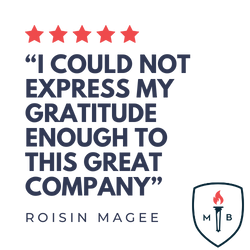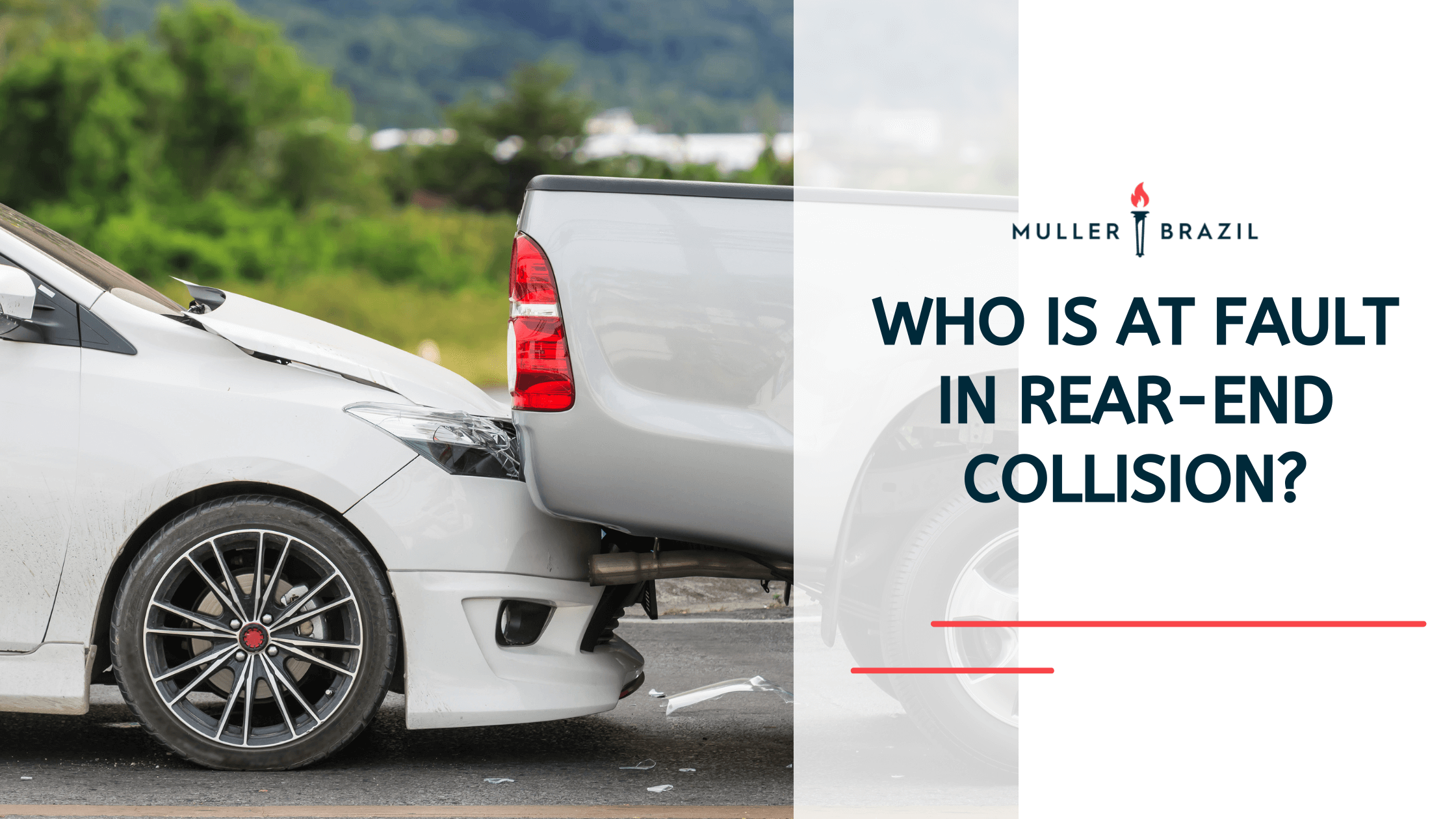In most rear-end collisions, the trailing driver is presumed at fault, but factors like brake checking, sudden stops, and broken brake lights can shift liability.
A rear-end accident can happen in an instant - one moment you’re driving safely, and the next, another driver has slammed into your vehicle’s brakes. Whether it’s caused by distracted driving, brake checking, or a sudden stop at a traffic light, determining fault in a rear-end collision is necessary for financial recovery.
Generally speaking, the rear driver is at fault because every motor vehicle operator is expected to maintain a safe following distance. However, certain circumstances surrounding the crash, like a flat tire on the lead vehicle or the first driver failing to use hazard lights - could shift some liability to the lead driver.
If you've been rear-ended or involved in a chain reaction crash with multiple drivers, understanding your legal rights is important. Here we will explain how fault is determined, when the rear driver's negligence is presumed, and how an experienced personal injury attorney can help you secure a fair outcome in your case.
Why Do Rear-End Collisions Happen?
A rear-end accident can occur for many reasons, but most involve driver negligence and a failure to leave enough distance to stop safely. While the rear driver is usually presumed to be the at fault driver, the circumstances surrounding the crash are important when establishing fault and securing financial recovery.
Common Causes of Rear-End Collisions
- Distracted Driving – One of the leading causes of rear-end crashes is distracted driving. When a trailing driver is texting, adjusting the radio, or not paying attention to the road, they may not see brake lights in time to react.
- Following Too Closely (Tailgating) – Drivers must leave adequate space between their motor vehicle and the lead vehicle. If the rear driver fails to maintain a safe following distance, they may be unable to react to sudden stops or slowing traffic.
- Speeding or Reckless Driving – Excess speed reduces a driver’s ability to react, increasing the risk of a rear-end accident. This is especially dangerous at traffic lights, intersections, and highways.
- Brake Checking – Some aggressive drivers engage in brake checking, where the lead driver slams on their vehicle’s brakes to intimidate the trailing driver. While this can contribute to a rear-end collision, proving that the lead driver was at fault can be difficult.
- Defective or Malfunctioning Brakes – If a vehicle’s brakes fail due to poor maintenance or a manufacturing defect, the rear driver may be unable to stop in time. Similarly, broken brake lights on the lead vehicle can prevent the trailing driver from knowing when to slow down.
- Poor Road Conditions or Weather – Rain, snow, and ice can make it harder for drivers to maintain control and stop safely. In these cases, multiple drivers may be involved in a chain reaction crash, making determining fault more challenging.
Contact Us Now
When Is the Rear Driver Legally Responsible for a Rear-End Collision?
In most cases, the rear driver is presumed to be the liable party in a rear-end accident. Traffic laws require drivers to maintain an assured clear distance between vehicles to allow enough time to stop safely. When a rear-end crash occurs, it often means the trailing driver failed to follow these laws.
However, insurance companies and courts don’t just assume fault, they rely on evidence to establish liability.
How Fault Is Proven in a Rear-End Collision
- Police Reports – Officers assess the circumstances surrounding the accident and may cite the rear driver for a traffic law violation.
- Witness Accounts – Statements from other drivers or bystanders can help confirm that the rear driver was following too closely or failed to react.
- Skid Marks & Roadway Evidence – Lack of skid marks may suggest the trailing driver was distracted and didn’t attempt to brake.
- Vehicle Damage – The location of the vehicle damage can indicate how fast the trailing driver was going and whether they attempted to stop.
- Dash Cam or Traffic Camera Footage – Video evidence can capture critical details, such as whether the lead driver used their brake lights or if the rear driver’s negligence played a role.
Can the Lead Driver Be at Fault in a Rear-End Collision?
While the rear driver is usually considered the liable party in a rear-end accident, there are situations where the lead driver may share responsibility. Determining fault depends on whether the lead driver’s actions contributed to the crash.
When the Lead Driver May Be Partially or Fully at Fault
- Brake Checking – If the lead driver intentionally slammed on their vehicle’s brakes to startle the trailing driver, they could be held responsible for reckless driving.
- Sudden Stops Without Reason – While traffic conditions sometimes require sudden stops, an unnecessary stop in moving traffic can shift fault to the lead driver.
- Malfunctioning Brake Lights – If the lead vehicle had broken brake lights, the trailing driver may not have had enough warning to stop safely.
- Unsafe Merging or Cutting Off Another Vehicle – If the lead driver merges too closely in front of another car without leaving enough space, they could be held liable for causing the auto accident.
- Stopping in the Road for No Reason – If a driver stops in an active lane of traffic, such as on a highway, and does not use hazard lights, they could be at fault for the rear-end crash.
Comparative Negligence and Shared Fault
In states that follow comparative negligence laws, both drivers can be found legally responsible for a rear-end accident. For example:
- If the rear driver was following too closely, but the lead driver had broken brake lights, both parties may share liability.
- If the lead driver engaged in brake checking, but the trailing driver was also speeding, they could both be assigned a percentage of fault.
In these cases, the rear driver may still be able to recover damages, but the amount will depend on their percentage of fault in the car accident. An experienced personal injury attorney can review the circumstances surrounding the crash and help determine who is legally responsible.
What Damages Can You Recover After a Rear-End Collision?
If you were rear-ended in a car accident, you may be entitled to financial recovery for your injuries and losses. The amount of compensation you can receive depends on the severity of your vehicle damage, medical expenses, and other factors.
Types of Compensation in a Rear-End Accident Claim
Medical Expenses
Example: Lisa, a 32-year-old teacher, was rear-ended at a red light and suffered whiplash and a herniated disc. Her medical treatment included:
- Emergency Room Visit: $3,500
- MRI Scan & X-Rays: $2,000
- Chiropractic & Physical Therapy (6 Months): $6,500
- Pain Management & Medications: $1,200
- Total Medical Compensation: $13,200
In severe cases, such as spinal cord injuries or surgeries, medical expenses can exceed $100,000 - $500,000.
Lost Wages and Reduced Earning Capacity
Example: John, a 40-year-old construction worker, suffered a back injury in a rear-end collision and was unable to work for three months.
- Monthly Salary: $5,000
- Time Off Work: 3 Months
- Lost Wages Compensation: $15,000
If the injury results in permanent disability (e.g., John can no longer lift heavy objects and must take a lower-paying desk job), compensation for reduced earning capacity could be $500,000+ over a lifetime.
Vehicle Damage Repairs or Replacement
Example: A rear-end crash damaged Maria’s sedan, requiring major repairs.
- Rear Bumper Replacement: $2,500
- Trunk & Taillight Repairs: $1,800
- Alignment & Frame Damage Repair: $3,700
- Total Repair Costs: $8,000
If the car is declared a total loss, the payout will typically match the vehicle’s fair market value (e.g., $25,000 for a 3-year-old Honda Accord).
Pain and Suffering
Example: David, a 50-year-old accountant, suffered chronic neck pain and PTSD after a high-speed rear-end crash. His lawyer argued for compensation based on:
- Physical Pain & Chronic Whiplash (Daily Discomfort): $50,000
- PTSD & Anxiety While Driving: $25,000
- Reduced Quality of Life (Unable to Enjoy Hobbies): $30,000
- Total Pain & Suffering Compensation: $105,000
In minor cases, pain and suffering may range $5,000 - $25,000, while in severe, life-altering cases, it can exceed $500,000+.
Punitive Damages (Extreme Negligence Cases)
Example: A driver was texting and speeding when he rear-ended a vehicle at 60 mph. The victim’s attorney proved reckless behavior, leading to a punitive damages award of:
- Punitive Damages: $250,000
- Total Settlement (Including Other Damages): $700,000
Punitive damages are rare but can be $100,000+ when extreme negligence (e.g., drunk driving, road rage brake-checking) is involved.
What Should You Do After a Rear-End Collision?
If you were involved in a rear-end accident, taking the right steps immediately after the crash can protect your health, strengthen your insurance claim, and help in establishing fault.
Steps to Take After a Rear-End Crash
Check for Injuries and Seek Medical Attention
- Even if you don’t feel hurt right away, some injuries - like whiplash from a rear-end collision or concussions can appear later.
- If you suffered severe injuries, seek emergency medical care immediately.
Call the Police and File a Report
- A police report is key in proving fault and can be used as evidence when dealing with insurance companies.
- Officers will document skid marks, road conditions, and statements from both drivers and witnesses.
Gather Evidence at the Scene
- Take photos of vehicle damage, brake lights, turn signals, and road conditions.
- Collect witness accounts and ask for their contact information.
Report the Accident to Your Insurance Company
- Notify your driver's insurance company, but be cautious about admitting fault or accepting a low settlement.
- If the other driver’s insurance company contacts you, avoid giving recorded statements without legal advice.
Consult an Experienced Personal Injury Attorney
- If the at fault driver or insurance companies dispute liability, a car accident lawyer can help gather evidence and build your case.
- An attorney can negotiate a fair settlement and, if necessary, take legal action to secure full financial recovery.
How Muller Brazil Can Help with Your Rear-End Accident Case
Dealing with a rear-end collision claim can be frustrating, especially when insurance companies try to minimize payouts or dispute driver's fault. At Muller Brazil, we fight for accident victims to make sure they receive the compensation they deserve.
Why Choose Muller Brazil?
- We handle the legal process for you – From gathering police reports and witness statements to negotiating with insurance companies, we take care of the details so you can focus on recovery.
- We fight for maximum compensation – Whether you’re dealing with severe injuries, lost wages, or vehicle damage, we push for the best possible outcome.
- We offer personalized legal guidance – Every case is unique, and our team makes sure that you understand your rights and legal options.
Protect Your Rights and Secure Fair Compensation
A rear-end accident can lead to severe injuries, vehicle damage, and complicated insurance claims. While the rear driver is usually at fault, certain circumstances surrounding the crash - such as brake checking, poor road conditions, or malfunctioning brake lights can make determining fault more complicated.
If you were rear-ended and are struggling to get fair compensation, Muller Brazil can help. Our team understands the tactics insurance companies use to reduce payouts, and we fight to make sure that you receive the financial recovery you deserve.
Meet the Author
Paul Brazil - Founding Partner
Paul Brazil is a native of Dunmore, Pennsylvania and a graduate of Dunmore High School. For his undergraduate education, he attended Bloomsburg University where he majored in political science. He then went on to earn his JD from Widener University School of Law. Following graduation from law school, Mr. Brazil worked at a large Philadelphia civil defense firm where he litigated workers’ compensation claims and Heart and Lung Act cases.
Learn more about Paul Brazil ⇒





